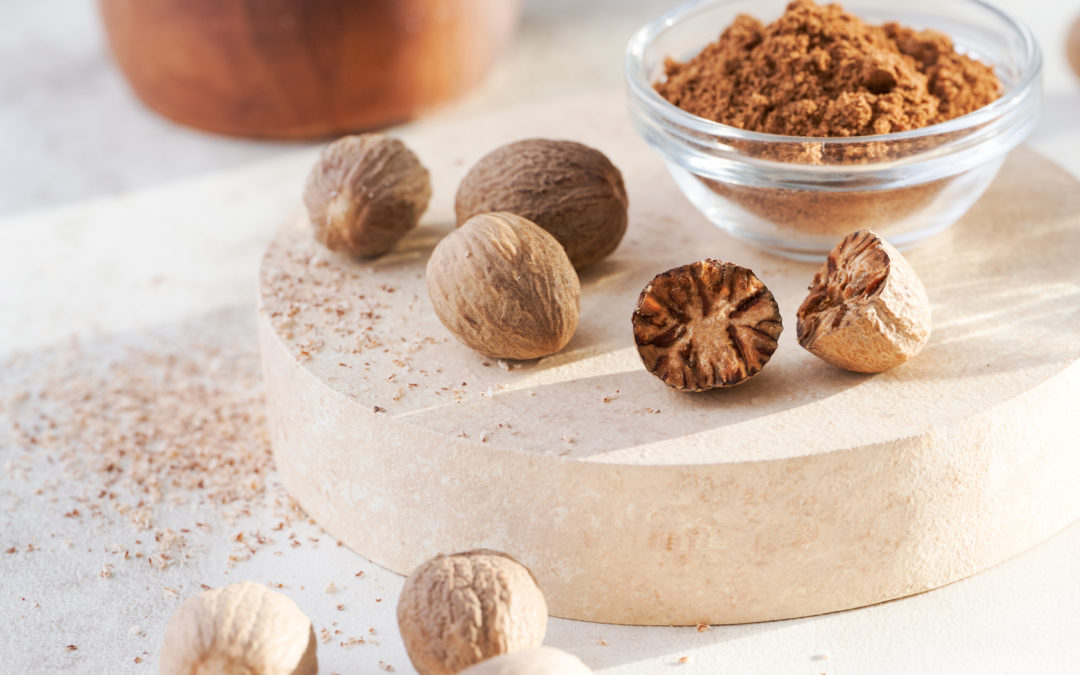Nutmeg is one of the most distinctive and beloved spices on the planet. During the holiday season, this spice is especially celebrated for its rich, slightly sweet flavor and naturally warming qualities.
This blog dives into the history, origins, and common uses of the nutmeg seed and also includes some notes about its sister spice, mace.
Appearance
Nutmeg comes from the yellow fruit of Myristica fragrans, a tropical evergreen tree that is native to the islands of Indonesia. These yellow fruits, resembling small apricots, contain a hard round seed from which nutmeg is produced. Around the seed is a thin, lacy crimson seed covering, or aril, from which mace is produced. The seed is oval-to-round in shape and about an inch long. Its surface has ridges and wrinkles covered in dark veins. These veins contain its volatile oil.
When the fruit of the tree is harvested, the “blades” of mace are carefully peeled away from the seed shell and dried. The nutmeg seed is left inside its seed shell to dry, after which the shell is broken and the seed is removed
Flavor
Nutmeg is naturally sweet, warm, and woody, with a slightly nutty undertone. It’s remarkably aromatic, and is so potent that it’s best when used in very small quantities.
Mace and nutmeg have similar flavor profiles which make them virtually interchangeable. However, mace is preferred in recipes where slightly sweeter, more delicate flavors are desired.
History
Mention of nutmeg and mace are scattered throughout the oldest scriptures of Hinduism and Chinese Literature where they were hailed for their believed medicinal properties.
Since its discovery in the spice trade, the nutmeg tree was held in high esteem and even fought over. Until the late 18th century, it was only grown in Indonesia. When the Dutch took control of Indonesia, they held a monopoly on the market. The seeds were eventually smuggled out of the area and into the British West Indies, a place that quickly became the second most prominent supplier of nutmeg and mace in the spice trade.
For years, there was confusion in the spice trade around the fact that the same plant that produced nutmeg also produced mace. According to the American Spice Trade Association, it’s rumored that the Dutch governor was once ordered to burn the nutmeg trees to make space for more mace trees.
Origins/Quality Sourcing
Today, there are two basic types of nutmeg:
- East Indian: This type is darker in color and higher in steam volatile oil content which makes it highly aromatic and flavorful compared to its counterpart.
- West Indian: This type is lighter in color and lower in steam volatile oil content which makes it milder in aroma and flavor compared to its counterpart.
At Pacific Spice, we are dedicated to sourcing the highest quality spices and herbs. Our products are sourced from reputable, approved sources to ensure a flavorful and dependable addition to your favorite dishes.
Storing
In accordance with spice storage best practices, these spices should always be tightly sealed and stored in a cool, dry, dark place; above ground and away from the wall. When they are stored properly, spice products can stay fresh for up to one year.
Uses
Nutmeg and mace are most commonly categorized as baking spices, but both spices are highly versatile. They are easily used to add depth of flavor and complexity to cooked foods like soups, meats, and curries, as well as other foods like pickled veggies and pound cakes.
Both spices are also highly compatible with dairy products such as eggnog and cheesecake.
PSC Nutmeg
At Pacific Spice, we sell the highest quality nutmeg products:
- PSC Nutmeg Whole
- PSC Nutmeg Ground
- PSC Mace Ground
If you’re interested in ordering from PSC, contact us about our products! When you source from us, we will help you determine the proper product for your individual needs.


Hello is there have a chance for being a suplyers for spices to your company?